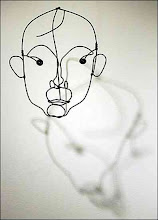If my recent posts regarding Hofstadter’s theories on selfhood interest you, then you should go see Inception. I won’t go too far into it for fear of spoiling the film for you, but I will say that the film seems to take a lot of recent cognitive theory as a kind of foundation for most everything that happens in the film. Memes, strange loops, the construction of consciousness on the foundation of episodic memory, it’s all there. One might even say that the architecture of mind provides the very setting of the story.
My favorite image from the film is an infinite regression (the film is full of doubling), which calls to mind Hofstadter’s writing on strange loops. When Ellen Page’s character (not so subtly named Ariadne) first begins experimenting with “building” environments inside dreams, she constructs facing mirror walls with herself and DiCaprio’s character standing between the mirrors, creating a series of infinite images of the two of them. Hofstadter uses an image of this kind (a camera pointing at the monitor showing the camera’s feed) as the model for what he calls “strange loops” and a metaphor for consciousness. It’s a stunning image in the film; I wish I could find a still of it to share with you here. There's a very bad quality pirated clip (shot in a theatre) onilne, but I won't link to pirated material here.
The image also immediately reminded me of an image I saw in another film last week—Escape from the Planet of the Apes, of which I caught a few lucky minutes while flipping channels. In one scene, there is an interview where an expert (Dr. Otto Hasslein) is asked to explain how time travelling apes could be possible. [Okay, I’ve stopped laughing now and can return to typing.]
I wasn't able to find a clip of this scene, but here is a link to the screenplay. Read shots 45-51. The explanation even uses the term “infinite regression.”
The explanation provided is ludicrous as a response to the question of time travel, but it is actually a very good way of imagining Hofstadter’s idea of the strange loop as the source of consciousness. The landscape in Hasslein’s metaphor gets represented by an input/output mechanism (could be a person, a robot, but here, let’s call it an “artist”) and the very attempt of the mechanism to “put itself in the picture” (that is, to see itself) creates the infinite regression, or strange loop, that is consciousness. What would it take to make a robot capable of making that leap, of asking that question?
This is all related to Gian Lombardo’s comment here a few weeks ago regarding Uncertainty and the inability of an observer to both be part of the system and to measure the whole system. But the argument made by Hofstadter and others is not that we don’t need to measure down to the fine grain, we only need to see the effects of the fine-grain mechanics (in fact, that’s what consciousness is, what thought is). The thought (the memes, the software) pushes the fine-grain mechanics around. Thinkodynamics.
But back to that image of the facing mirrors. This image, like many images in Inception (the Penrose stairs, the sudden intrusions of memory into the present, etc.) is designed to establish and reinforce a basic assumption about selfhood in the film, and, of course, refer us back to the film itself as a mirror of experience and a metaphor for our episodic consciousness. Where among all of the episodes is the self? Is it the conglomeration of the episodes? Or is consciousness the act of gazing back through the episodes and seeing the gaze reflected back? An infinitely regressing image of a wrench is just an image; an infinitely regressing image of an infinitely regressing image that wonders which iamge is the "real" one is a consciousness.
Naturally, I want to extend these questions, then, in regard to poets. Some poets seem to be interested only in the landscape. Many poets seem to be interested only in the collecting consciousness (or just the self without a bit of interest in the collecting, even). The poets that interest me most tend to be those who are trying to figure out how the collecting consciousness fits into, is a part of, and relates to the "landscape". Stevens, Williams, Ammons, Charles Wright, Olson, later Brenda Hillman, early Jorie Graham, Gary Young, Cendrars, Charles Simic in Dimestore Alchemy, Jack Spicer, John Yau leap to mind.
Subscribe to:
Post Comments (Atom)




No comments:
Post a Comment